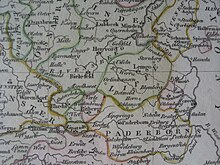Lippstadt
This article needs additional citations for verification. (September 2009) |
Lippstadt | |
|---|---|
 Lutheran Saint Mary's Church | |
Location of Lippstadt within Soest district  | |
| Country | Germany |
| State | North Rhine-Westphalia |
| Admin. region | Arnsberg |
| District | Soest |
| Subdivisions | 18 |
| Government | |
| • Mayor | Christof Sommer (CDU) |
| Area | |
| • Total | 113.3 km2 (43.7 sq mi) |
| Elevation | 79 m (259 ft) |
| Population (2023-12-31)[1] | |
| • Total | 69,047 |
| • Density | 610/km2 (1,600/sq mi) |
| Time zone | UTC+01:00 (CET) |
| • Summer (DST) | UTC+02:00 (CEST) |
| Postal codes | 59555-59558 |
| Dialling codes | 02941 |
| Vehicle registration | SO, LP |
| Website | www.lippstadt.de |
Lippstadt (German: [ˈlɪpʃtat] ) is a town in North Rhine-Westphalia, Germany. It is the largest town within the district of Soest.
Geography
Lippstadt is situated in the Lippe valley, roughly 70 kilometres east of Dortmund and roughly 30 kilometres west of Paderborn. The historic town centre is situated between an artificial canal of the river Lippe and the river itself.
Neighbouring municipalities
Division of the town
Lippstadt consists of 18 districts:
|
|
Twin towns — sister cities
Lippstadt is twinned with:
 Uden, Netherlands, since 1971
Uden, Netherlands, since 1971
History
In the early 13th century Lippstadt, with a population of 2700, had four parish churches. There was an Augustinian abbey which had existed since 1281.

From 1400, the enclave and town of Lippstadt was to be a condominium shared by the county of Lippe and the counts of Cleves-Mark, who were succeeded by the Hohenzollerns (Brandenburg/Prussia), a situation that endured until the middle of the 19th. century.[2]
Heinrich von Ahaus founded one of his communities for women of the Brethren of the Common Life there.
In 1523 it formed a defensive alliance together with the neighbouring cities of Osnabrück, Dortmund, Soest and Münster.
Augustinians studying at the University of Wittenberg brought Martin Luther's doctrine home with them. Thus in 1524 Lutheran doctrines were preached at Lippstadt by their prior Westermann, and the town was one of the first to embrace Lutheranism officially, though it resisted the rise of Calvinism in rural areas of Westphalia.
Colonel Edward Morgan, (c.1616- after 1665), a Royalist during English Civil War 1642-9, was Captain General of the Kings (Charles I) forces in South Wales. After the King's arrest and execution, he fled to the continent, and married Anna Petronilla the daughter of Baron von Pöllnitz from Westphalia, Governor of Lippstadt. They had six children, two sons, and four daughters. He was later appointed Lieutenant Governor of Jamaica 1664-65. His nephew Henry Morgan left his Jamaican property to his godsons Charles Byndloss (b.1668) and Henry Archbold on condition they adopted the surname of Morgan. These were the children of his two cousins Anna Petronilla Byndloss (née Morgan), and Johanna Archbold (née Morgan).
In 1821 the Papal Bull "De salute animarum", made over to the Bishopric of Paderborn the Lippian parishes of Cappel, Lipperode and Lippstadt, which had previously belonged to the Archbishopric of Cologne without producing any ensuing agreement with the state of Lippe.
In 1851 the whole of Lippstadt, which up to then had been divided between the Kingdom of Prussia and Lippe, was added to the Prussian royal province of Westphalia.
In 1944 a women's subcamp of Buchenwald was founded in Lippstadt. It was also the site of a displaced persons camp in the years following World War II. On 1 April 1945 the US 2nd Armored Division made contact with the 3rd Armored Division at Lippstadt, effecting junction of the US Ninth Army with the US First Army, and seized the city against scattered resistance.[3]
Notable natives and residents
- David_Gans David ben Shlomo Gans Hebrew: דָּוִד בֶּן שְׁלֹמֹה גנז (b. 1541 in Lippstadt, d. 1613 in Prague), Jewish mathematician, historian, astronomer and astrologer
- Anton Praetorius (b. 1560 in Lippstadt, d. 1613), theologian, fighter against witchcraft trials and torture
- Anthony Eickhoff (b. 1827 in Lippstadt-Benninghausen, d. 1901 in New York City), German-American author and politician
- Martin Niemöller (b. 1892 in Lippstadt, d. 1984), theologian
- Kaspar Ulenberg, Lutheran convert to Catholicism, theological writer and translator of the Bible into German
- Rudolph Blankenburg, b. in Lippstadt, became a naturalized United States citizen and mayor of Philadelphia
- Karl-Heinz Rummenigge (b. 1955 in Lippstadt), former German footballer
Economy
Lippstadt serves as headquarters of international automotive supplier Hella. It is also home to a factory of large-diameter antifriction bearings, seamless-rolled rings manufacturer Rothe Erde.
References
- ^ "Bevölkerung der Gemeinden Nordrhein-Westfalens am 31. Dezember 2023 – Fortschreibung des Bevölkerungsstandes auf Basis des Zensus vom 9. Mai 2011" (in German). Landesbetrieb Information und Technik NRW. Retrieved 2024-06-20.
- ^ G. Benecke, Society and Politics in Germany 1500-1750, University of Toronto Press, 1974, p. 42
- ^ Stanton, Shelby, World War II Order of Battle: An Encyclopedic Reference to U.S. Army Ground Forces from Battalion through Division, 1939-1946 (Revised Edition, 2006), p. 50


